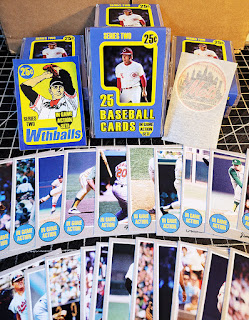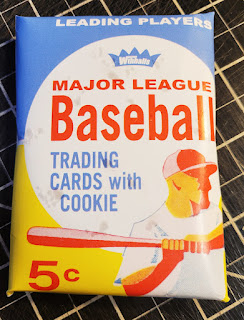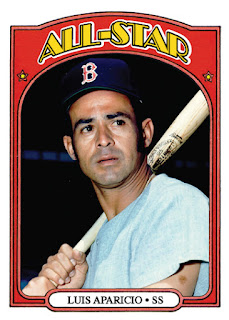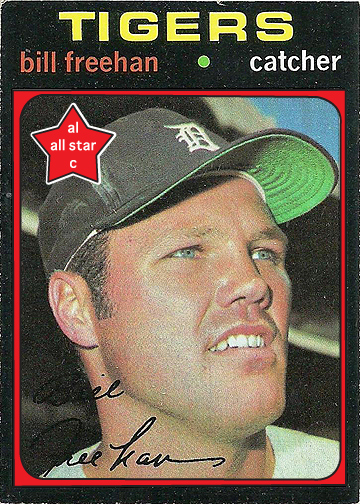On the blog today, a card I created a while back that I never profiled here on the blog to my surprise, my 1970 "In-Game Action" card for "Little Louie" Aparicio, from me Series 2 set released a couple years back:
Thursday, April 25, 2024
1970 "IN-GAME ACTION": LUIS APARICIO
Sunday, April 14, 2024
1960S ALL-DECADE TEAM: A.L. SHORTSTOP LUIS APARICIO
Time for our next player to be named to my 1960s All-Decade All-Star team, with today's entry the American League shortstop of the 1960s, and I chose Luis Aparicio:
Tuesday, February 13, 2024
1969 "DO-OVER" SET: LUIS APARICIO
Up on the blog today, we take a look at my "redo" for Luis Aparicio and his 1969 card, fixing the reuse of images Topps had originally put out there due to their spat with the MLBPA:
Friday, December 2, 2022
STARS RETIRE: 1974 WILLIE MAYS & LUIS APARICIO
On the blog today, another in my "Stars Retire" thread, this time a 1974 edition celebrating the careers of recently retired Willie Mays and Luis Aparicio:
By the time the 1970's hit, he was a walking legend of the sport, and being enshrined in the Baseball Hall of Fame in 1979 was the cherry on top of it all.
Wednesday, October 5, 2022
REVISITING A POST FROM AUGUST, 2014: "THEN & NOW" LUIS APARICIO
On the blog today, revisiting an old post from August 18th of 2014 celebrating the career of "Little Louie" Aparicio, Hall of Fame shortstop who wrapped up a brilliant career in 1974:
Wednesday, April 27, 2022
SPECIAL SPOTLIGHT: "LOST" 1963 FLEER SECOND SERIES: LUIS APARICIO
The next player from my recently released 1963 "Lost Second Series" custom set to get featured here on the blog is "Little Louie", Hall of Famer Luis Aparicio:
He was both a member of the “Go-Go” Chicago White Sox in 1959, helping them reach the World Series, as well as the surprising 1966 World Champion Orioles, who shocked the world by sweeping the reigning champion Los Angeles Dodgers in the World Series.
The ten-time All-Star also took home nine Gold Glove Awards, teaming up with Nellie Fox to form one of the greatest double-play combos of all time.
He led the AL in fielding percentage eight straight years, between 1959 and 1966, while also leading in assists seven times, putouts four times and double-plays twice.
Friday, December 31, 2021
1972 ALL-STAR SUB-SET: LUIS APARICIO
Next up in the "missing" 1972 All-Star sub-set parade is Hall of Fame shortstop Luis Aparicio, the starter for the American League in the 1971 Midsummer Classic:
From 1956 through 1964 he led his league in steals every single time, that’s nine straight years, with a high of 57 in 1964 playing for the Baltimore Orioles.
He was both a member of the “Go-Go” Chicago White Sox in 1959, helping them reach the World Series, as well as the surprising 1966 World Champion Orioles, who shocked the world by sweeping the reigning champion Los Angeles Dodgers in the World Series.
The ten-time All-Star also took home nine Gold Glove Awards, teaming up with Nellie Fox to form one of the greatest double-play combos of all time.
He led the AL in fielding percentage eight straight years, between 1959 and 1966, while also leading in assists seven times, putouts four times and double-plays twice.
In 1984 he was selected for Cooperstown by the BBWAA, joining former teammates like Frank & Brooks Robinson & Early Wynn, with others like Nellie Fox and Jim Palmer joining him later on.
Sunday, February 18, 2018
NICKNAMES OF THE 1970'S: "LITTLE LOUIE" APARICIO
Nowadays, we have a guy like Jose Altuve leading the way for players that are not built like mountains, and Aparicio fit that bill between 1956, when he took home the American League Rookie of the Year Award, through the 1973 season, when he retired with over 2600 hits, 1300 runs and more than 500 career stolen bases.
From 1956 through 1964 he led his league in steals every single time, that’s nine straight years, with a high of 57 in 1964 playing for the Baltimore Orioles.
He was both a member of the “Go-Go” Chicago White Sox in 1959, helping them reach the World Series, as well as the surprising 1966 World Champion Orioles, who shocked the world by sweeping the reigning champion Los Angeles Dodgers in the World Series.
The ten-time All-Star also took home nine Gold Glove Awards, teaming up with Nellie Fox to form one of the greatest double-play combos of all time.
He led the AL in fielding percentage eight straight years, between 1959 and 1966, while also leading in assists seven times, putouts four times and double-plays twice.
In 1984 he was selected for Cooperstown by the BBWAA, joining former teammates like Frank & Brooks Robinson & Early Wynn, with others like Nellie Fox and Jim Palmer joining him later on.
Monday, August 18, 2014
THEN AND NOW #10: LUIS APARICIO 1974
Friday, July 25, 2014
"GIMME A DO-OVER"- PART XXXIV: 1971 #740 LUIS APARICIO
Friday, February 21, 2014
"1960'S ALL-DECADE TEAM" SUB-SET FOR THE 1970 TOPPS SET: SHORTSTOPS
Friday, June 21, 2013
THE MISSING ALL STAR CARDS: 1973 TOPPS: AMERICAN LEAGUE
I kept the design simple to match the overall 1973 set design Topps used. The location of the "all star stripe" seemed to be a natural at the bottom. It keeps the image unobstructed while still calling out the "all star" designation.
After a win in the 1971 game for the A.L., which was their first since 1962, it was back to the losing side as they lost this one in extra innings, 4-3. As a matter of fact the American League would end up losing every All Star game up until 1983.
Of note here: the Freehan card is an excellent example of an "action shot" done right. The in-game action, the player clearly represented, and look at that crowd in the background. Awesome as they are clearly hanging on the play at the plate, waiting to see the outcome.
Carl Yastrzemski is called out as a first baseman on his card, but was voted into the all star game as an outfielder. Dick Allen was the starting first baseman for the A.L.
Tomorrow I'll post the National League starting nine.
Wednesday, June 19, 2013
THE MISSING ALL STAR CARDS: 1972 TOPPS: AMERICAN LEAGUE
Instead of an separate "all star" sub-set, the players would be tagged all stars on their regular issue cards.
I went with a simple bar-design running across the bottom of the card, just above the player's name. The A.L. got a red bar, while the N.L., which I will post tomorrow, got green.
Again, these are the players that were voted to the starting line-up, so even though Ray Fosse, Boog Powell and Tony Oliva didn't play because of injuries, they still get the all star tag-line.
Of course, Reggie Jackson, who didn't get voted in as a starter, was the player with the biggest impact on the 1971 All Star game, hitting a mega-blast off the light tower that instantly became legendary.
As a matter of fact, this game featured six home runs, and ALL six were hit by future Hall of Famers: Frank Robinson, Reggie Jackson, Harmon Killebrew, Johnny Bench, Roberto Clemente and Hank Aaron.
Frank Robinson's homer made him the first player to ever hit home runs as a member of both leagues.
Monday, June 17, 2013
THE MISSING ALL-STAR CARDS: 1971 TOPPS: AMERICAN LEAGUE
Since I'm a fan of the latter, I've started to recreate all the cards of players between '71-'73 that should have been all-stars.
It's interesting because you have your usual all-stars like Bench, and Carew, but you also have some guys like Glenn Beckert and Dock Ellis that get a nice "bump" on their cards with an "All-Star" tag.
Please note that these "selections" were solely based on voter results from the year before, as Topps did to designate all-stars themselves. So whether or not the player actually started the previous years' all-star game, or if they didn't appear at all (due to injury), they got the all-star nod.
Today we'll start with the American League all-stars for the 1971 set. So obviously these are the guys that were voted in by fans for the 1970 game (except for pitcher of course. They were selected by the manager).
Tomorrow I'll post the National League all-stars from the same set, ending this thread with the National League all-stars from the 1973 set on Saturday.
What I did for the 1971 set was give a star designation (like the '75 and '76 sets), as well as giving the white border around the player photo a color: red for A.L. and yellow for N.L.
The reason I decided on this was mainly due to what Topps did for their 1971 football set, where "all-pros" had a different color for their borders than "regular" cards.
Notice that even though Harmon Killebrew was the starting Third Baseman for the American League in 1970, his card shows him as a First Baseman for the 1971 season.
Also of note: check out the great airbrushing job Topps did with Aparicio, who was traded to the Red Sox on December 1st, 1970, from the White Sox. You can clearly see the White Sox jersey in the photo.
FOLLOW ME ON TWITTER...
Everything baseball: cards, events, history and more.













































